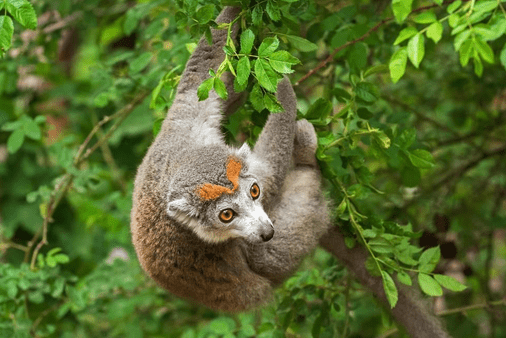Eulemur coronatus
IUCN
LCBasic Information
Scientific classification
- name:Eulemur coronatus
- Scientific Name:Eulemur coronatus,Crowned Lemur
- Outline:Primates
- Family:Lemuridae Lemuridae
Vital signs
- length:34-36cm
- Weight:1.5-1.8kg
- lifetime:25-36years
Feature
A crown-shaped head with prominent color on the brow line and sides of the eyes
Distribution and Habitat
The crested lemur is found in the archipelago of Madagascar off the coast of East Africa. It is confined to the northernmost part of this island. The range extends from the northernmost area south of the Fanambana River in Chan de Ambre. This species extends westward as far as the Sambirano River in the town of Ambilobe and its range goes east of the coastline. The crested lemur is found in the dry forests of Chan de Ambre and Sakalava. These lemurs are more frequently found in the forest canopy rather than in the edge or degraded forest areas.
It is found in tropical rainforests, in moist montane forests and in dry deciduous forests. The lemur is arboreal and spends most of its time in the upper layers of the tree canopy.
Appearance
The average size of the crested lemur is about the size of a small domestic cat. It is the smallest species in the genus. Total length is 75-85 cm, head and body length is 34-36 cm, tail length is 41-49 cm; weight is 1.5-1.8 kg; skull length is 8 cm; ear length is 4 cm. The name of this species is due to the crown-shaped head with obvious coloration on the brow line and on both sides of the eyes. The head is usually orange. Sexually dimorphic, males are chestnut brown overall, with gray-brown upper parts and pale lower parts, black tails, gray faces, and black noses. There is a V-shaped black hair on the top of the head, and a circle of chestnut brown hair on the forehead, forming a distinct crown. Females have smaller crowns and white abdomens.
They have bright orange eyes, and the lower 6th incisor and canine teeth form a tooth-shaped comb, which is a typical lemur feature. In addition, all lemurs have long tails, which are used for balance.
Details
Crowned Lemur (scientific name: Eulemur coronatus) is the smallest species in the genus.

Crowned Lemurs live in groups, but the groups are not fixed. Usually the group is 5 to 15 individuals, sometimes 9-12 together. Each individual smears urine on its body for scent identification. Territories overlap, but neighboring groups generally avoid contact. Highly adaptable to the forest. These groups usually contain several adult males and females. Special calls may be used to keep different groups in contact. The crowned lemur is active at different times throughout the day and night, from sunrise to sunset, but they often take a midday break for up to 4 hours.
The crowned lemur mainly feeds on fruits. These animals spend most of their time on the ground in various forests. During the rainy season, lemurs eat leaves. In the dry season, lemurs look for water in deep caves. Forage in trees or on the ground. Omnivorous, the main food is fruits, plants and gums, and also eats bread, biscuits, monkey food, bananas, apples, guavas, tomatoes, monkey rice cakes, papayas, flower cucumbers, carrots, etc. In some areas, they also eat insects, centipedes, millipedes, etc.
Crested lemurs breed seasonally, mating usually occurs in May-June. Gestation period is about 125 days. Breeding period is from late May to June, and birth period is between mid-September and October. The young are born before the rainy season. Usually single babies, twins are also common. Parental care lasts until the age of 5 to 6 months. Sexual maturity takes about 20 months. Captives can live up to 36 years. Lifespan is reduced in the wild.
Human development, environmental damage and poaching are the main threats to lemurs. These lemurs live in the Montagne de Ambre National Park in the Ambre Forest. They are all listed as a group of conservation concern by the World Conservation Union. Today, conservation measures are aimed at better educating local residents about wildlife protection.
Listed in the 2008 Red List of Endangered Species of the World Conservation Union (IUCN) ver 3.1 - Vulnerable (VU).
Listed in the CITES Appendix I of the Washington Convention as a protected animal.
Protect wild animals and eliminate game.
Maintaining ecological balance is everyone's responsibility!








